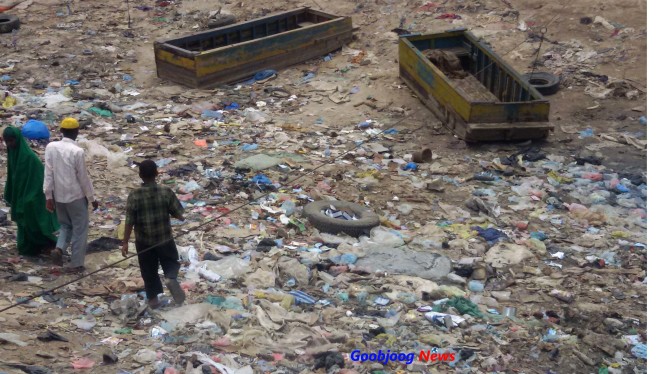Climate change focus: Thousands at risk as River Shabelle dries up

By Goobjoog News Team
An investigation by Goobjoog News has revealed threats to food security and human life as the once deep and running Shabelle river which is the bedrock for pastoralists in Hiiraan, Middle Shabelle and Lower Shabelle regions is fast drying and crop failure setting in.
These three regions are the country’s food basket supplying food to Mogadishu and other regions of the country and for export.
Goobjoog News commissioned an investigation with a team of reporters crisscrossing the Hiiraan, Lower Shabelle and Middle Shabelle regions to verify reports the once beautiful river is fast fading away.
In Middle Shabelle region people are anxious about the river water changes. Villages such as Mandera, Ba’adly and Daymosame face unprecedented water shortages.
For the first time in 35 years according to locals Shabelle River is drying out. Small boats which once were submerged in the river can now be seen as the river bed is bare and dry littered with waste. The river is the main water source for many Somali farmers and nomads who rely on it for their animals.
The effects stretch to cover Somaliland, Galmudug and Puntland which are currently undergoing alarming drought situations.
Shabelle River
Shabelle River extends from Ethiopian highlands and enters Somalia in Hiiraan region where it passes Baladweyne, Bulabarde, Jalalaqsi and dozens of villages. The river in Hiiraan region still has water flowing but it has changed in colour and the taste. A pale green colour covers the water indicative of pollution.

The Food and Agriculture Organisation, FAO last year warned Food production, mostly along Jubba and Shabelle rivers, was likely to be dramatically affected, at least in the short-term following the El Nino rains which hit the northern and central Somalia. These, expert attribute to climate change in the Horn of Africa.
Residents in the main city, Baladwene now have to walk 15km away into a village known as El-gal. Other cities and village in Hiiraan have the same burden now since they cannot use the river water for drinking or cooking.
Disease outbreak
Farmers and nomads of the region find themselves in middle of water crises, says Goobjoog News correspondent, Khalid Mohammad who was part of the investigative team. Communities on river banks are scared of water disease breakout. Children go to the river frequently. Community leaders have expressed their concern about the possibility of disease breakout.
In Bula-barde town which is one of the main towns in Hiiraan region, residents not only face water shortage but they have also been under Al-Shabaab siege for two years. The militants have blocked supply routes cutting off the town from any support.
Commissioners of regions report this is one of worst water shortage crises in 40 years in the region. Aways Hassan, the commissioner of Mandera village says due to the change of river water in taste and colour, people are forced to water from wells which he says are too salty to be consumed.

“Residents are left to make do with water from wells since the water from the rivers is no longer fit for use. However water from wells is too saline to be consumed,” said Hassan.
Surane Ahmed Shabelle, the commissioner of Deymosame village confirms that two kids recently died over consumption of contaminated water.
In Ba’adly village where at least 575 families live, a similar narrative runs through. Residents are concerned about their well being after some people died of water related deaths. A village commissioner also confirmed this to Goobjoog News.
Water company
The capital city of Middle Shabelle region, Jowhar enjoys relative water adequacy thanks to local water company called Farjano. Farjano supplies running water to all four districts of the town but farmers and some pastoralists outside the town do not get the service.
Goobjoog Correspondent in Middle Shabelle, Adan Hussein Da’ud says at least 400 villages in the region need urgent attention from government and aid organizations. Water and food remain a major challenge.
In Lower Shabelle region, the river has completely dried out. “For the last two weeks, residents have not seen any water in the river. Farmers and nomads around river bank are extremely worried about this situation,” Mustaf Haji Ali 55 says. Crops failure, hunger and thirst are becoming subjects discussion among communities that live in once the most productive parts of the country, add Ali.

Ali old farmer notes the region has experienced crop failure owing to lack of rains and drying up of rivers. Yousuf Mumin Ali is farmer who grows maize and other crops to support his family and now he is worried about the dry out of the river.
Another farmer, Yusuf Mumim Ali is worried the drying up of river Shabelle is putting his family at risk since his maize crop has failed. Ali, like other farmers depend on the river for irrigation but the current situation is subjecting them to untold suffering.
The three regions Hiran, Middle Shebble and Lower Shabble are generally agriculturally rich regions in Somalia but the drying up of river is posing a threat to not only the farming community but also other parts of the country. Cities like Mogadishu depend on the three regions for fresh produce but failed crop could further jeopardize the city’s economy.